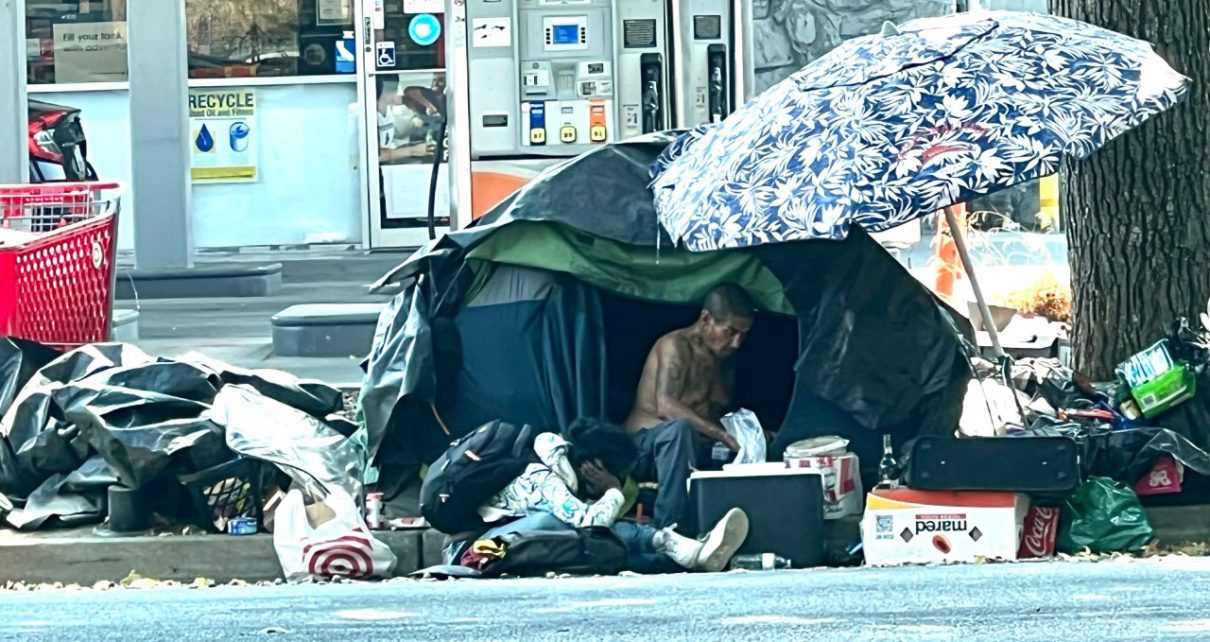
Homeless transients living on sidewalk at Union 76 gas station, W Street, 16th Street. (Photo: Katy Grimes for California Globe)
New HUD Report Shows U.S. Homelessness Increases – As Do the Budgets of the Responsible Agencies
House and Urban Development reports 653,000 people were homeless – 12% increase
By Katy Grimes, December 16, 2023 9:04 am
Despite spending untold billions on the homeless, we now have 653,000 homeless people in the United States – 70,650 more than last year, a 12 percent increase, House and Urban Development (HUD) announced Friday in a new report.
Homelessness would largely cease to be a problem if the US government would stop the spending, providing meager incomes for drug addicts who buy drugs instead of paying for rent and food. Housing and food vouchers would take care of that.
“On a single night in 2023, roughly 653,100 people – or about 20 of every 10,000 people in the United States – were experiencing homelessness. Six in ten people were experiencing sheltered homelessness—that is, in an emergency shelter (ES), transitional housing (TH), or safe haven (SH) program—while the remaining four in ten were experiencing unsheltered homelessness in places not meant for human habitation,” HUD announced.
In response to this epic failure, HUD Secretary Marcia Fudge said:
“Homelessness is solvable and should not exist in the United States,” said “From day one, this administration has put forth a comprehensive plan to tackle homelessness and we’ve acted aggressively and in conjunction with our federal, state, and local partners to address this challenge. We’ve made positive strides, but there is still more work to be done. This data underscores the urgent need for support for proven solutions and strategies that help people quickly exit homelessness and that prevent homelessness in the first place.”
She’s full of it.
United States Interagency Council on Homelessness Executive Director Jeff Olivet said:
“Even in communities where homelessness is rising, it doesn’t mean they aren’t helping people exit homelessness. In many cases, the problem is that for every person who moves off the street and into a home, more than one loses a home and becomes homeless. The 2023 PIT data illustrates this, and until we close the doors to homelessness, we will not end it. That is why preventing homelessness is a priority for this administration and a major part of All In: The Federal Strategic Plan to Prevent and End Homelessness,” Olivet said in a written statement today that includes a list of the administration’s major investments and initiatives since this data was collected.
Along with the report, HUD also released a fact sheet summarizing the data, a fact sheet on the key findings, and a “fact sheet highlighting communities where homelessness declined” from 2022 to 2023.
Which cities cut homelessness?
Chattanooga, TN, Dallas, TX, Houston, TX, Newark/Essex County, NJ.
Olivet claims that the root cause of homelessness is the lack of affordable housing, “and the high cost of housing that have left many living paycheck to paycheck and one crisis away from homelessness.”
Actually, Bidenomics and inflation did that.
What are the 19 federal agencies that make up the United States Interagency Council on Homelessness?
- AmeriCorps
- U.S. Department of Agriculture (USDA)
- U.S. Department of Commerce (DOC)
- U.S. Department of Defense (DOD)
- U.S. Department of Education (Education)
- U.S. Department of Energy (DOE)
- U.S. Department of Health and Human Services (HHS)
- U.S. Department of Homeland Security (DHS)
- U.S. Department of Housing and Urban Development (HUD)
- U.S. Department of Interior (Interior)
- U.S. Department of Justice (DOJ)
- U.S. Department of Labor (DOL)
- U.S. Department of Transportation (DOT)
- U.S. Department of Veterans Affairs (VA)
- General Services Administration (GSA)
- Office of Management and Budget (OMB)
- Social Security Administration (SSA)
- U.S. Postal Office (USPS)
- White House Office on Faith-Based and Neighborhood Partnerships (FBNP)
Is it any wonder homelessness is growing?
USICH says, “Homelessness has no place in America. All In: The Federal Strategic Plan to Prevent and End Homelessness (herein referred to as All In) is a multi-year, interagency blueprint for a future where no one experiences homelessness, and everyone has a safe, stable, accessible, and affordable home.”
And
“Ending homelessness requires an all-hands-on-deck response grounded in authentic collaboration.”
I’m sure that the 19 agencies lent an “all-hands-on-deck response” – and yet homeless grew by 12% – as did the budgets of the 19 agencies:
Americorps 2023 budget was $1,312,806,000. Its 2024 budget will be $1,478,624.
The US Department of Agriculture (USDA)’s total outlays for 2024 are estimated at $228.3 billion.
The 2024 budget request for the U.S. Department of Defense (DoD) is $842 billion – the FY 2024 request grows by nearly $100 billion (13.4 percent) over a 2-year period.
The DOD budget grew more than homelessness…
The 2022 DOD budget included $34.4 “supplementals” and the 2023 DOD budget included $35.8 billion “supplementals,” explained this way: “supplemental funding for Operation Allies Welcome ($6.512 billion), Natural Disaster Relief ($895 million), Red Hill Bulk Fuel Storage Facility ($350 million), and Ukraine ($26.632 billion). FY 2023 includes supplemental funding for Ukraine ($35.678 billion) and Disaster Relief ($147 million).”
The 2023 US Department of Education budget shows “$274.36 Billion in budgetary resources,” “$254.91 Billion in total obligations, and “$86.71 Billion in award obligations.”
As for HUD, the 2023 budget for U.S. Department of Housing and Urban Development is/was $71.9 billion, approximately $11.6 billion more than the 2022 annualized continuing resolution (CR) level. In addition, HUD requested $35 billion for the Housing Supply Fund, a new mandatory program providing grants to State and local housing finance agencies and their partners to invest in strategies to increase the supply of affordable housing.
You get the picture – all spending in Washington DC is going up – including on homelessness – which apparently only serves to facilitate more homelessness, despite protestations claiming otherwise. Spending on the homeless is just another way to spend billions and redistribute taxpayers’ earnings.
Remember, the US Interagency Council on Homelessness claims, “Ending homelessness requires an all-hands-on-deck response,” in a plan “built around three foundational pillars—equity, data, and collaboration—and three solution pillars—housing and supports, homelessness response, and prevention. Each pillar includes strategies the federal government will pursue to facilitate increased availability of and access to housing, economic security, health care, and stability for all Americans.”
Bullpucky.

- Newsom’s Leaked Draft Redistricting Maps Show Gerrymandering on Steroids of California’s New Congressional Districts - August 15, 2025
- California Media Ignores Redistricting ‘Power Couple’ Jodi Hicks and Paul Mitchell - August 15, 2025
- CA Globe Editor Katy Grimes Joins Jon Fleischman on Inaugural Podcast - August 14, 2025








Katy Grimes is absolutely right of course to call B.S. on this endless nationwide derelict growth industry. What a dirty racket, and what a lot of money there is still to be made from this gusher, and apparently lots and lots of politicians and agencies and bureaucrats and the rest of ’em want “All In.”
But the Dem/Marxists & Friends really need to freshen up their dishonest patter, just a bit, for variety’s sake if for nothing else, because the more the average citizen hears a politician say “I am absolutely committed to ending homelessness” the more that citizen knows he or she is in for an even bigger hosing than the time they heard it before. Meanwhile the miserable mess grows and grows and grows, and with no end in sight.
Our greedy Dem/Marxist ‘ruling class’ knows what to do to get a handle on this, the template is there, the one that has been shown to work, but why do that when there is no money or vote-buying or God only knows what else in eradicating this scourge once and for all? Also we know they will register to vote as many derelict zombies as they can get their hands on and then have the handy paid-off usual helpers fill out the resulting flood of mail-in ballots the way the Dem/Marxists like it, so there’s that, too. Nothing is going to change as long as these scoundrels are in charge. Will we be able to chase the resident swindlers and hangers-on out of office in spite of all?
Let’s talk about how amending CA SB 1380: Homeless Coordinating and Financing Council can help solve a lot of problems. SB 1380 says you don’t have to be “clean and sober” to stay in shelters or receive “housing”. If sobriety and enrollment in drug treatment programs WERE required, I think the homelessness be reduced.
The mental health issues remain on the streets because the Feds won’t pay for mental health facilities with more than 16 beds. Why? Supposedly because of the stigma of the “big state run loony bins” of yesteryear. (eye roll)
Vagrancy is a growth industry for SEIU and Homeless Inc, in California.
Newsom needs to learn how they boost their revenues every year.
Grow a problem and get more cash. They must use a secret sauce.
I agree that Ms. Fudge is full of BS, but I do agree with her on one point in that homelessness is totally solvable. The remedy is to shut down the government Homeless/Housing Industrial complex and the NGO’s that they fund at all levels of government (they could refund those savings to we the taxpayers). I can’t recall one issue that the government has actually solved. If I am missing out on a problem that the government has actually solved, please let me know so I can stop being cynical.
I’ll make a pitch for community colleges as one government operation that still works fairly well – you still get the most bang for the buck from them in higher education.
Which by K-12 default is still too often remedial education that community colleges are required to provide, but someone has to do it when the indolent child finally realizes they actually want to be a responsible adult. Community colleges are there for them. Community colleges still offer vocational training, provide cost effective lower division education for transfer, and are a pretty decent cross-section of who actually we are in this state.
Community colleges offer first chances for many, and second chances for a lot more too. With the abject failure of far too many four-year colleges preparing students for lifetimes of petty resentments and ill-informed unhappiness, it is worth saving community colleges for the students who have no time for such useless indulgences.
That is, if you can avoid taking a community college class from Dr Jill.
The article from California Globe highlights a concerning trend: despite significant increases in budgets allocated to combat homelessness, the United States has seen a 12% rise in homelessness, with approximately 653,000 individuals affected.
This paradox raises critical questions about the effectiveness of current strategies and the allocation of resources. It’s alarming to consider that, despite the involvement of 19 federal agencies, including AmeriCorps and the U.S. Department of Housing and Urban Development, the problem continues to escalate.
While officials like HUD Secretary Marcia Fudge assert that “homelessness is solvable and should not exist in the United States,” the persistent increase suggests a disconnect between policy intentions and outcomes.
It’s imperative that we critically assess these initiatives to identify and address the root causes of homelessness, ensuring that increased funding translates into tangible improvements for those affected.